The history of Dudgeon’s Wharf is one of civil war, blockade running, disastrous ship launches, bankruptcy, fire, insanity and – in 1969 – the terrible explosion that claimed the lives of 6 men. My teenage years were spent just a couple of hundred yards from the site of their wharf at the north end of Saunders Ness Rd (formerly Wharf Rd), and I had no idea of its remarkable history.
J & W Dudgeon, Shipbuilders
Like many of the great Victorian engineers, especially on the Island, John Dudgeon (1816-1881) and William Dudgeon (1818-1875) were Scottish. After starting their career as blacksmiths, they moved south to gain experience with some of the leading engineering companies of the age. The Isle of Dogs at that time had a very high proportion of Scottish residents, as witnessed by the Scottish church St Pauls, and the numerous Islanders with Scottish ancestry even as recently as the end of the 20th century.
In the 1851 census, William was reported as living in Albert’s Place – a very modest row of terraced houses on West Ferry Rd – approximately opposite Moiety Rd – along with his wife Emma and 2 yr-old daughter Mary. His profession is given as ‘Engineer’. 10 years later he is reported to be a widow, and yet another 10 years later, in the 1871 census, he was living in the much more well-to-do Vanbrugh Park in Blackheath.
(A few years later, the nearby, mock-gothic Vanbrugh Castle would be purchased by Alexander Duckham, the oil merchant who also started his business life on the Isle of Dogs, on Phoenix Wharf.)
John, meanwhile was Inspector of Machinery for the Board of Trade in 1851, and living in Ratcliffe, Stepney with his wife and two sons. In 1861, he was Marine Engineer Master, living with his growing family in a grand house in Northfleet, Kent along with assorted cooks, servants and maids. There they remained there for at least the next 10 years.
In 1856, John and William had set up the The Sun Iron Works on Lollar Wharf, off the West Ferry Rd opposite the Tooke Arms. One of their first contracts was to build an engine for the Thunder, a ship designed by John Dudgeon and being built by Messrs Lungley in Deptford.
The Thunder was launched in December 1859, and soon demonstrated that she was the fastest steamer yet provided with a screw propeller. She was a handsome vessel, ship-rigged, with clipper bows, and her masts and funnels had a slight rake which gave her a very attractive appearance.
R. A. Fletcher – Steamships, the Story of their Development to the Present Day (1910)
In 1861 the brothers went into shipbuilding themselves, at a yard directly south of Pier St (which at the time crossed Manchester Rd).
The Dudgeons were the first to build significant numbers of vessels with (independently driven) twin-screw engines and to demonstrate their worth.
The first ship they built was the 150-foot Flora, the first twin-screw steamer to cross the Atlantic Ocean.
The innovative twin-screw design allowed much faster and fuel-efficient steamships to be built, The result was fast and highly manoeuvrable ships with low draughts that were ideally suited for events taking place on the other side of the Atlantic Ocean.
Blockade Runners
A few days after the American Civil War broke out on April 12, 1861, President Lincoln announced a land and sea blockade of the rebellious, southern states. The newly formed Confederate States of America had only 35 ships in its navy, and turned to privateers to penetrate the blockade, using fast steamships that could outrun the Union ships.
These vessels would carry cargoes to and from neutral ports often located in Nassau and Cuba where neutral merchant ships would handle the transatlantic transport. Ships bound for the Confederate states usually carried badly needed supplies and mail, outbound ships often exported cotton, tobacco and other goods for trade to Europe (primarily to Britain, which had vast cotton business interests).
The Dudgeon brothers exploited this situation and specialized in the manufacture of fast twin-screw blockade runners for the Confederacy, at times employing up to 1500 men at their yard between Manchester Rd and the river.
One of the most famous Dudgeon-built blockade runners was the CSS Tallahassee. Originally developed for the opium trade in China, the Tallahassee was converted into a second class gunboat, retrofitted with a 100-pounder rifle, 32-pounder rifle, 30-pounder Parrot rifle and a brass howitzer. She became famous for events that took place close to the end of the Civil War.
During a brilliant 19 day raid, from her home port of Wilmington, North Carolina, and return, the Tallahassee created absolute havoc with Union commerce along the Atlantic seaboard. In this short period, she destroyed 26 vessels and captured 7 others that were bonded or released. The 13 knot, twin-screw, man of war, with a complement of 120 officers and men, had sailed in early August to engage in this mission of destruction.
The cruiser’s Master was Captain John Taylor Wood, a grandson of Zachary Taylor, 12th President of the United States. Captain Wood appears to have been well connected, because he was also a nephew of Jefferson Davis, who at the time was President of the Secessionist States.
– http://freenorthcarolina.blogspot.nl/
Unlike many firms on the Island, J & W Dudgeon survived the economic crisis caused by the collapse of the Overend, Gurney & Co. bank. In fact, they had so many outstanding ship orders that in 1869 they took over the disused yard to the south, bordering Pyrimont Wharf.
However, the company was to suffer a fatal blow in 1874, with the disastrous launch of their 70th ship – the 300 ft long frigate Independencia for the Brazilian Government. The Dudgeons attempted to launch her on 16 July but she stuck fast and did not budge. A second attempt was made on 30 July during which the ship got about one-third down the slipway and stuck, extensively damaging her hull plating.
As reported in the Times:
She was finally launched on 10 September after she had been lightened. The contract for the vessel’s repair and refitting went to the rival firm of Samuda Brothers. After a year of sea trials with the Brazilian navy, she was acquired for the Royal Navy in 1878 and renamed HMS Neptune. Her commission ended in 1903, and while being towed to the breakers, she unintentionally rammed HMS Victory, collided with HMS Hero, and narrowly missed several other ships. The accident-prone ship was scrapped in Germany in 1904.
For a list of the ships built by J & W Dudgeon, see http://oceania.pbworks.com/w/page/26361403/Dudgeon
The cost of the botched launching resulted in the bankruptcy of the Dudgeons in 1875. William Dudgeon died in the same year.
Both events took a serious emotional toll on John, who was declared insane. The census of 1881, the year of his death, has him residing as a patient at a private “Lunatic Asylum” in West Malling, Kent.
From Shipbuilding to Oil Storage
Dudgeon’s Wharf was taken over in 1882 by City oil and petrol merchants Ingall, Phillips & Company. They extended the wharf and built a large number of circular storage tanks, many of which were below ground level. But, just two years after this massive investment, they made a miscalculation that led to their bankruptcy. New York Times:
London, 27 Dec. 1884. The failure of Ingall, Phillips & Co., the great wharfingers of St. Mary Axe, with liabilities amounting to $1,000,000, has completely demoralized the oil trade in London. They had a corner in turpentine which promised to be very profitable, but they were short on petroleum to the extent of 30,000 barrels, and the rise in petroleum [prices] sent them to the wall. Their failure will doubtless embarrass the market seriously on Monday. Petroleum traders predict a catastrophe owing to the want of confidence in wharfinger warrants caused by the failure. Hitherto wharfinger warrants have been considered above suspicion, and have been looked upon as equal to bank notes for the value, at current rates, of the amount of oil represented on their face.
By 1885 the premises had been taken over by the newly-formed London Oil Storage Company, and in the following year a serious fire broke out on the site.
The conflagration – as serious as it was – did not mean the end of the company, and in 1918 it was taken over by London & Thames Haven Oil Wharves Ltd (although it continued to trade with its original name).
The next few decades passed uneventfully, although it was a close thing in the evening of 7th September 1940 – the first night of the blitz – when a high explosive bomb dropped close to the wharf. The fire brigade’s log of the incident reported only some damage to brickwork.
Perhaps it’s accurate to say that WWII was one of the periods when the wharf enjoyed good fortune. Bombs dropped all around, but its over 100 tanks with capacities up to 20,000 gallons remained unscathed. It was a close thing though – as this map reveals – buildings destroyed or damaged beyond repair by bombing are marked in red:
Tragedy
In 1951, operations stopped at Dudgeon’s Wharf, which remained empty for many years before demolition work commenced. It was during this work that tragedy struck on 17th July 1969:
The demolition was rife with danger and difficulties and firefighters had frequently attended the site after sparks from cutting gear ignited small fires.
Less than two weeks before the fatal explosion, 40 men with eight pumps had tackled a fire on waste oil in a derelict tank and now another call arrived at Millwall Fire Station at 11.21am alerting the emergency services to another fire.
Two appliances were sent from Millwall in F Division and another from Brunswick Road. A foam tender from East Ham was sent later along with a fireboat from Greenwich.
Station Officer Innard, believing the fire to be out when he arrived, decided to put a curtain of water into the open top manhole of Tank 97.
Four other officers joined him on top of the tank to feed in the water. Later reports concluded that this pull of water drew air into the tank, mixing with the flammable vapours.
S.O. Innard then decided to ensure there was no further fire by opening the bottom manhole. Unable to find a spanner to undo the nuts, it was suggested they should be burned off.
As soon as a workman applied the cutting flame of his torch to the first nut, the vapours inside the tank ignited immediately, blowing the roof off the tank, together with the five firefighters and a worker.
The explosion happened at 11.52. Three appliances were sent from Bethnal Green and Bow. Their role was to collect the bodies.
– Giles Broadbent, http://www.wharf.co.uk
The victims were named as:
- Michael Gamble, London Fire Brigade, Millwall Fire Station
- Alfred Smee, London Fire Brigade, Millwall Fire Station
- John Appleby, London Fire Brigade, Brunswick Road Fire Station
- Terrance Breen, London Fire Brigade, Brunswick Road Fire Station
- Paul Carvosso, London Fire Brigade, Cannon Street Fire Station
- Richard Adams, A&R Metal Company
This was the largest single loss of life in the London Fire Brigade since the Second World War.
Clearance
Photos taken in the 1980s by Mike Seaborne, showing a cleared Dudgeon’s Wharf.
The site was later developed for housing. The street names have a nautical theme (Chichester Way, Mariner’s Mews, Sextant Avenue, etc), but none reflect the history of the wharf. Perhaps it was something to which the developers would rather not draw attention.
On Thursday 24th December – more than 40 years after the event – a plaque commemorating the victims of the 1969 explosion was unveiled by London’s fire commissioner Ron Dobson at a service on the former Dudgeon’s Wharf.
The unveiling was 150 years to the month after the launch of Dudgeon’s first commercial success – the steam ship Thunder in December 1859.


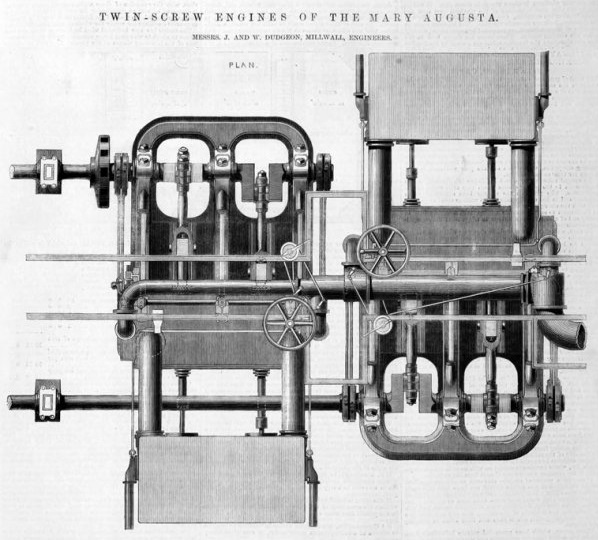

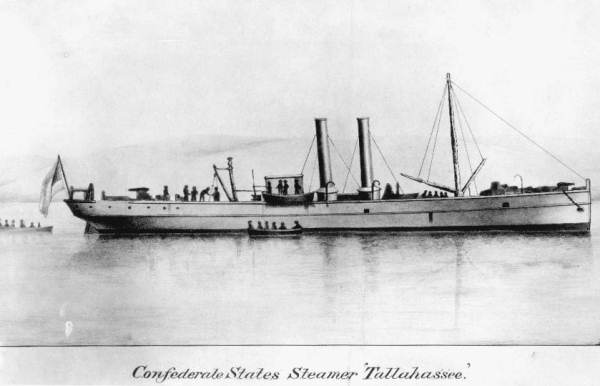








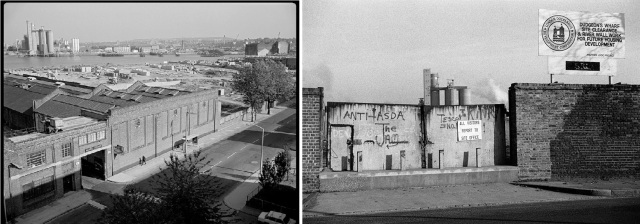
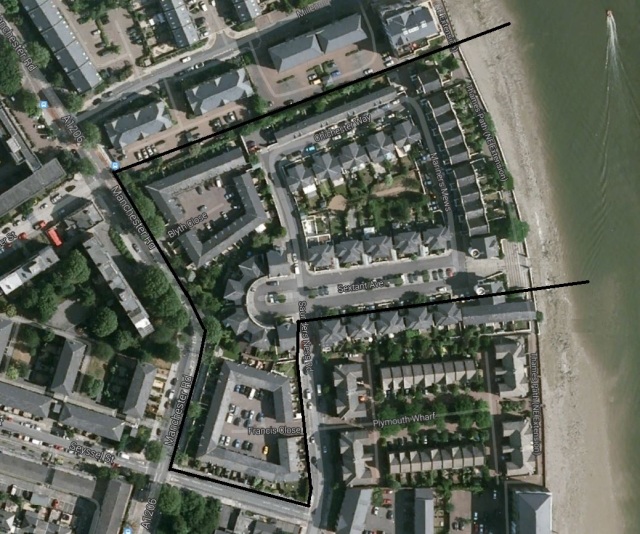


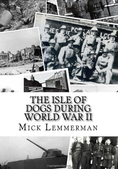


John & William Dudgeon’s grandmother Helen Dudgeon (nee Runciman) was orphaned in 1765 when, ironically, her father William Runciman was drowned in a fishing tragedy. http://www.wikitree.com/wiki/Space:Crail_Fishing_Disaster
I wonder whether John & William were related to my grandfather Andrew Tilstone Dudgeon, ship builder on Tyneside with Swan Hunter in mid to late 1800s. Descended from family living in East Lothian near North Berwick. (Bienstoun & Markle??)
Very probably. The Dudgeons in this article are from East Lothian too.
John Dudgeon had a son Alexander John and another William Leigh Dudgeon. They were both signatories of the petition to The Commissioners of Lunacy requesting they hold an Inquisation to declare their dad of Unsound mind (4.11.1975). Alexander John was involved in the yard as he was reported in Newspapers as being aboard vessels on sea trials.
I was a Fireman aged 19 yrs .and on duty in the “F” Divisional watch room @ Stratford on this day, unbeknown to me in the first instance that anything untoward had happened in the “F” Division area until senior officers cars left F21 Stratford Fire Station on the Blue Light,
En route to the Isle of Dogs.. As all contact was made to Control by Land Line instead of Appliance Radio…. When Senior Offices arrived at Dugeons Wharf Radio Contact was resumed…. And as can be imagined Things became Very busy….. I was honoured to be picked to be one of the Pall Bearers for Michael Gamble at his Funeral,
The streets were lined with members of the Local Public who were showing their gratitude and respect following the Tragedy of Dugeons Wharf…. I am now 65 yrs of age and remember my collegues of the L.F.B who lost their lives on that Summers Day in 1969 .
GOD BLESS THEM ..
as the saying goes….”THERE BUT FOR THE GRACE OF GOD, GO I”
Raymond Sherman …… Ex L.F.B.
Thanks for your comment, Raymond.
regards, Mick
My name is Jim Rogers. I joined the LFB in 1963 at age 21. In 1969 I was on the Red Watch at F23 Millwall. I was at the time a Acting Leading Fireman. Bob Horwood was Acting Sub Officer. It was Bob who had drawn the highly hazardous demolition methods on the site to the LFB Fire Prevention Branch after we had attended two fires there on the same day. An inspection was carried out by the FPB and the contractors were advised to adopt cold cutting techniques to lessen the risk of more fires occuring. All this was long before the arrival of The Health and Safety and Welfare at Work Act became a reality. I knew well all the Firefighters who lost their lives that tragic day. Both Bob and I were called as witnesses to the Public Enquiry that was convened to investigate and report on incident and the fatalities.
I remember the funerals which were held at a church in Stratford. Each of our fallen comrades were carried with full Brigade Honours on five Turntable Ladder appliances. RIP Brothers.
Thanks for writing, Jim. During the week, I coincidentally came across a news report made by ITN a day or two after the tragedy. I don’t know if you’ve ever seen it, but you can find a link to it on this page (no sound unfortunately): http://www.islandhistory.co.uk/films.html. This might also be of interest, our collection of Island photos, including Millwall Fire Station (you’ll have to scroll down a bit): https://www.flickr.com/photos/islandhistory/sets/72157646556840268/
thanks again
regards
Mick
Dear Mr Lemons
I have been researching the history of Dudgeons since I came across the brief memoirs of William Hammock who was manager of their engineering works.
Are there any photos of the yard or including the yard during its brief but prolific history?
Brendan O’Farrell
Hello Brendan, I’ve not seen any older photos of Dudgeon’s (unfortunately). When was William Hammock working there? Knowing that might help if I have dig around. Cheers. Mick.
Hammock joined Dudgeons in 1859 and was there until they went bust in 1875. I think his design/draughtsman skills complemented the brothers who came from the hands on end of engineering. Afterwards he had two or three offers of partnerships in other yards. However, he had been so stressed by the affairs of Dudgeons and other personal pressures that he was content to take a job supervising the building of three steamers on the Clyde. I did a presentation about Dudgeons at the DHG Symposium on London Shipbuilding in May.
Pingback: DON FRANCISCO CUNILL Y EL FIN DEL VIZCAYA | Vida Marítima
Dear Mick,
I am researching some of the deceased buried in Brockley & Ladywell cemeteries – I note that a William Dudgeon ( died 1875) is buried in Ladywell cemetery and assume? that it would be the same WD who you have helpfully described in your v informative article ?
Regards
Mike Guilfoyle
Vice-Chair Foblc
I imagine it was him. The year of death matches, and William Dudgeon lived at 3 Talbot Place in Blackheath at the time of his death, not far from Ladywell Cemetery.
My name is Paul Bailey I arrived at Dugeons Wharfe at the make up on F26 Bernal Greens Pump as we arrived they were removing Mick Gamble in a stretcher he’s was still alive at that time I was then ordered to search inside inside the bing wall for the other fireman there is a picture of me doing this in the Brigade archives. I also remember DO Abbit with tears running down his face as the loss of life became apparent. The following shift I was temporarily promoted to LFm at F23 Millwall it was Avery difficult time for me Stn O Innard was off sick and LFm Dodds had been temporarily promoted to Sub O. Fm Corvosso had lived at Millwall and he took the out duty there from Clerkenwell. I was at Millwall for many months St O Innard returned to duty but he was never the same person again and eventually retired. Hope this may help with some of the events that happened that day,
Thanks for your comments, Paul. It’s always good to hear personal experiences!
My brother in law was one of the firemen who,lost their lives in this fire. However there is a mistake with his name on the memorial plaque. Paul is his second name. His name is Trevor Paul Carvosso. I was pregnant with my daughter at the time and named her Paula in memory of Trevor Paul.
How upsetting. Have you or anyone else in the family contacted the London Fire Brigade about it, in order to have it corrected?
The inscription on the memorial to those lost in the tragic fire is the only place I have found the word Dudgeons in the area. When I started researching the shipyard a google search produced pages of items because building was going on at the time and it was referred to was the “Dudgeon’s Wharf Development ” and every estate agent around was trying to get a slice of it. It is a great shame that the developers failed to name a street or a building after a business which for 14 years from 1962 was the most prolific builder of merchant vessels and produced the first ever truely twin screwed steam ships. Perhaps one of the residents could name their house “Dudgeons”.
As you can see, I am of the family, and my antecedents also were East Lothian Dudgeons. I have a old family tree that shows the ‘Ship Building Dudgeons of London’. It does not show the link to my family, but notes that they came from ‘Stenton par(ish)’ which is about 4 miles as the crow flies from my ancestors’ villages in the 15th & 16th centuries. I can forward images of the tree if you wish (not feasible on this link?).
I am also pleased to say that the residents of Compass Point are interested in restoring the Dudgeon’s Wharf name in some way!
Hi Mike. yes I would love to have an image of your family tree. Please could you send it to me at ofarrell017@hotmail.com .I have had a paper published in Mariners Mirror on the autobiography of WG Hammock who was manager of Dudgeon’s engine works from 1859. Like other works managers he probably made huge contributions to engine development but the plaudits went to his bosses.
Pingback: The History of Saunders Ness Road | Isle of Dogs – Past Life, Past Lives
My father was a production manager for the oil company that had operated on the site, and had been moved to a different location in Marshgate Lane, Stratford, six months before the disaster occurred.
I remember as Child of six or seven years old, going to Dudgeon’s Wharf with my father if he ever had to go into work at weekends. It always seemed such an exciting place.
On the day the tragedy occurred my late mother commented on a plum of smoke that could be seen where we lived in Woodford. We later found out that it was in fact Dudgeon’s Wharf. It obviously really shook my father up at the time.
My father passed away in 2014 and when i was sorting out his stuff I found his copy of the public inquiry which is now in the possession of my son.
The two things I remember most about Dudgeon’s Wharf were the feral cats that lived in and around the yard, that were fed by some of the workers, and the boats that were moored up at the back of the site.
Hi Gordon,
Much appreciate seeing your comments on Dudgeon’s Wharf (for obvious reasons). I wonder whether your father understood the dangers inherent in the storage facilities when he was working on them? I suspect not, as I spoke with one of the firemen who had been involved in the post-accident enquiry, and it had resulted in a major change to the way chemicals etc were evaluated and graded for safety procedures. Regrettably, like Grenfell Tower, it sometimes takes a disaster for the implications of accepted procedures to be fully understood.
All best wishes, Mike (Dudgeon)